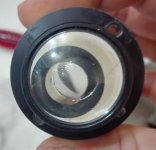Hello everyone,
I've got an old centre finding microscope, propably for an old german manual mill.
The microscope seems to have a defect, or is it a feature? Inside the optics there is a black, hollow cylinder and it is not fixed in place but moves around. This seems odd to me, but on the other hand I can't make out how this part was mounted fixed in there... I hope some pictures make it clearer. The black, off-center part moves around inside the optics.



I've got an old centre finding microscope, propably for an old german manual mill.
The microscope seems to have a defect, or is it a feature? Inside the optics there is a black, hollow cylinder and it is not fixed in place but moves around. This seems odd to me, but on the other hand I can't make out how this part was mounted fixed in there... I hope some pictures make it clearer. The black, off-center part moves around inside the optics.





